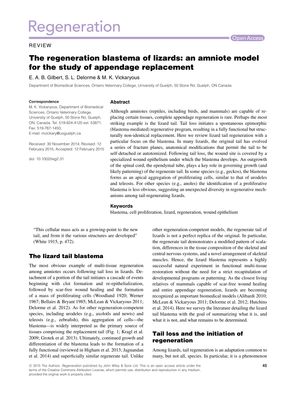The Regeneration Blastema of Lizards: An Amniote Model for the Study of Appendage Replacement
April 2015
in “
Regeneration
”

TLDR Lizards can regrow their tails, and studying this process helps understand scar-free healing and limb regeneration.
The document reviewed the process of tail regeneration in lizards, particularly the role of the blastema, a cell mass that proliferates to form a new tail after autotomy. It detailed the formation of a specialized wound epithelium and the development of the blastema beneath it, leading to a new tail that differs structurally from the original. The study suggested that blastema cells are likely lineage-restricted and that regeneration mechanisms vary among lizard species. It also identified the ependymal tube as a key organizer in regeneration, with potential molecular mechanisms including MMP-9 expression and TGFB signaling pathway activation. The research indicated that regeneration may involve dedifferentiation and stem/progenitor cell recruitment, with the ependymal tube possibly releasing trophic factors. The document emphasized lizards as valuable models for studying scar-free healing and appendage regeneration and called for more comparative studies to understand regenerative variability and evolution in lizards. The study was funded by the Natural Sciences and Engineering Research Council of Canada and supported by the Canadian Foundation for Innovation.
